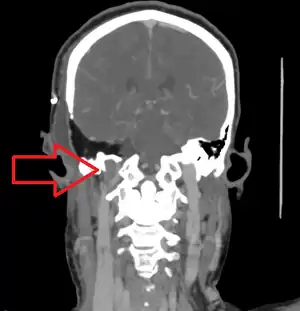Jugular vein thrombosis
| Jugular vein thrombosis | |
|---|---|
| Other names: Internal jugular vein thrombosis | |
 | |
| A post-operative internal jugular vein thrombosis on the person's right | |
| Symptoms | None, neck swelling[1] |
| Complications | Pulmonary embolism[1] |
| Types | Lemierre syndrome (due to infection)[1] |
| Risk factors | Cancer, central venous catheter, factor V Leiden[1] |
| Diagnostic method | Ultrasound, CT scan[1] |
| Differential diagnosis | Superior vena cava syndrome, mediastinitis, cellulitis[1] |
| Treatment | Generally anticoagulation[1] |
| Frequency | 7.5% people with both a central venous catheter and cancer[1] |
Jugular vein thrombosis is when a blood clot develops within the internal jugular vein (IJV).[1] While many have few or no symptoms, others develop swelling, tenderness, and redness of the neck.[1] A hard area along the vein may also be felt.[1] If infection occurs other symptoms may include fever and headache.[1] Complications may include pulmonary embolism.[1][2]
The most common causes are cancer and a central venous catheter.[1] Other risk factors include factor V Leiden, injury to the neck, ovarian hyperstimulation syndrome (OHSS), and intravenous drug use.[1] Cases that occur as a result of infection are known as Lemierre syndrome.[1] Diagnosis may be suspected based on the D-dimer and confirmed by ultrasound or CT scan.[1]
Treatment in those with a low risk of bleeding is generally with anticoagulation for 4 to 12 weeks. Medications used may include heparin and warfarin or a factor Xa inhibitor.[1] If possible the central venous catheter should be removed.[1] No specific treatment may be an option in those without symptoms.[1] Thrombolysis or surgery is rarely recommended.[1]
Jugular vein thrombosis affected 7.5% people with both a central venous catheter and cancer.[1] The risk of death in those affected is about 44% and is greater in those with other health problems.[1] Infected cases of jugular vein thrombosis were first described in 1936.[3]
Signs and symptoms
While many have few or no symptoms, others develop swelling, tenderness, and redness of the neck.[1] A hard area along the vein may also be felt.[1] If infection occurs other symptoms may include fever and headache.[1] Complications may include pulmonary embolism.[1]
Diagnosis
Diagnosis may be suspected based on the D-dimer and confirmed by ultrasound or CT scan.[1]
Other animals
Other animals may be affected including horses.[4]
Refences
- 1 2 3 4 5 6 7 8 9 10 11 12 13 14 15 16 17 18 19 20 21 22 23 24 25 26 27 28 Lee, Y; Siddiqui, WJ (January 2022). "Internal Jugular Vein Thrombosis". PMID 31082155.
{{cite journal}}: Cite journal requires|journal=(help) - ↑ Reinus, William R. (21 October 2013). Clinician's Guide to Diagnostic Imaging. Springer Science & Business Media. p. 166. ISBN 978-1-4614-8769-2.
- ↑ Caplivski, Daniel; Scheld, W. Michael (2 February 2012). Consultations in Infectious Disease: A Case Based Approach to Diagnosis and Management. Oxford University Press. p. 118. ISBN 978-0-19-990910-0. Archived from the original on 17 October 2022. Retrieved 16 October 2022.
- ↑ Sprayberry, Kim A. (2009). Current Therapy in Equine Medicine. Elsevier Health Sciences. p. 230. ISBN 978-1-4160-5475-7.